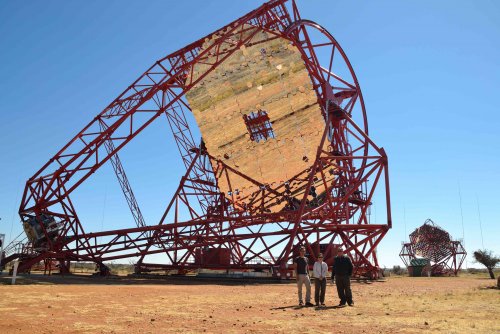Publications
Publications partielles de l’équipe Phénomènes de Haute Energie extraites de l’archive ouverte pluridisciplinaires HAL pour l’année en cours. (…)
The research of the PHE working group is aimed at increasing our knowledge about astrophysical sources and the physical processes at work inside these sources. Our work is based on the modelling of Active Galactic Nuclei (AGN) : we develop simulations to describe the physical and chemical processes at work in astrophysical plasmas of weak and moderate density (microscopic processes, radiation and radiative transfer). Our research is characterised by a pluri-disciplinary approach, combining theoretical aspects from atomic and molecular physics with observations covering the whole electromagnetic spectrum, from the radio band up to very high energy (TeV) gamma rays.

High Energy Phenomena
01 Active Galactic Nuclei
The unification scheme suggests a common interpretation of the different observed AGN (quasars, blazars, radio galaxies, etc.), which are distinguished only by their orientation with respect to the observer.
Within this model, AGN are composed of :
The analysis of emission spectra at the highest energies and of their temporal evolution is our best source of information on the central engine of AGN.

02 Observations of AGN in gamma rays
High Energy Astrophysics is the study of non-thermal sources, where charged particles are accelerated by shock-waves or in strong electromagnetic fields. These high energy particles can emit X-rays and gamma rays.
The international experiment H.E.S.S. (High Energy Stereoscopic System) has revealed the richness of the high energy sky, up to tens of TeV (=10^12 eV). The H.E.S.S. telescopes, installed in Namibia, observe galactic and extragalactic sources indirectly through the detection of Cherenkov light from particle cascades (air showers) generated in the atmosphere by high energy gamma rays.
Within the H.E.S.S. collaboration, our research is based essentially on the topic of compact objects, mainly in the field of Active Galactic Nuclei (AGN). Based on our experience in astrophysics, we contribute to the experiment on several levels (observations, modelling and interpretation of sources, multi-wavelength data analysis). Our group has also an expertise in the physics of atmospheric particle showers and in the reduction of raw data. In addition, we are working on the dissemination of the H.E.S.S. data according to the norms of the Virtual Observatory.
We contribute to the construction and exploitation of H.E.S.S. II, and also to the preparation of the international project CTA (Cherenkov Telescope Array), the next generation ground based gamma-ray observatory, which will combine several tens of telescopes. The scientists from the LUTh are involved notably in the definition of the science case for CTA, as well as in the simulations of telescopes and air showers and the definition of the data format.
Our group, in collaboration with engineers and researchers from the GEPI, are also constuction the first prototype of a Schwarzschild-Couder type telescope on the Meudon site. (SST-GATE)
03 Particle acceleration and magnetic fields
The investigation of high energy phenomena leads directly to the study of acceleration mechanisms of particles. In the solar system, the acceleration of matter takes place in the plasma inside the magnetosphere of magnetised planets and in the arches and flares of the solar corona. The strongly magnetised neighbourhood of pulsars implies extremely intense acceleration of electrons (and positrons). These are accompanied by coherent radio emission and X-rays and gamma rays, which allow us to characterise the properties of the accelerated particles. In the case of AGN, the acceleration mechanisms have to be very efficient to produce the relativistic particles the radiation of which we study. These environments, a priori quite different, do present some analogies that our working group is trying to exploit in its study of the acceleration processes.
